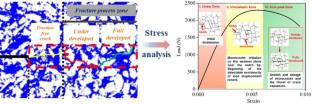Simultaneous determination of dynamic fracture toughness and tensile strength through a single three-point bending test
Abstract
The fracture process zone (FPZ) has been assumed to activate microcrack evolution and influence the mechanical parameters of the rock specimen. This can be linked to the grain size of the rock specimens located in the path of the crack propagation. However, few studies have considered the effect of the grain distribution on the size of the FPZ, especially under dynamic loadings. In this paper, we analyze the mechanism by which the strain rate and grain distribution affect the FPZ and the dynamic mechanical parameters. We selected three kinds of sandstone specimens to represent the mesostructure heterogeneities characterized by the fractal dimensions. Also, the size of the FPZ can be calculated by the grain size and the dynamic fictitious crack length under the quantified mesostructure heterogeneities and the concept of the box dimension method. Based on the results, the dynamic strength and fracture toughness can be obtained with unknown coefficients. The unknown coefficients were then determined via the dynamic fracture test, in which the processed semicircle bending (SCB) specimens were used for the pendulum hammer-driven split Hopkinson pressure bar (SHPB) apparatus. Finally, the results were validated using the existing experimental methods recommended by the International Society for Rock Mechanics (ISRM). This study provides a valid and simpler method for the simultaneous determination of the dynamic fracture toughness and tensile strength of rock specimens.


 求助内容:
求助内容: 应助结果提醒方式:
应助结果提醒方式:


